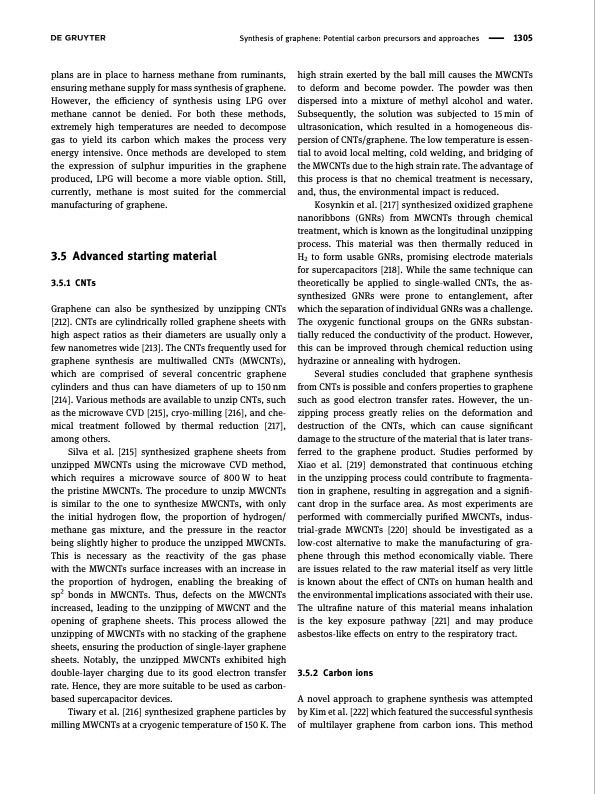
PDF Publication Title:
Text from PDF Page: 022
Synthesis of graphene: Potential carbon precursors and approaches 1305 plans are in place to harness methane from ruminants, ensuring methane supply for mass synthesis of graphene. However, the efficiency of synthesis using LPG over methane cannot be denied. For both these methods, extremely high temperatures are needed to decompose gas to yield its carbon which makes the process very energy intensive. Once methods are developed to stem the expression of sulphur impurities in the graphene produced, LPG will become a more viable option. Still, currently, methane is most suited for the commercial manufacturing of graphene. 3.5 Advanced starting material 3.5.1 CNTs Graphene can also be synthesized by unzipping CNTs [212]. CNTs are cylindrically rolled graphene sheets with high aspect ratios as their diameters are usually only a few nanometres wide [213]. The CNTs frequently used for graphene synthesis are multiwalled CNTs (MWCNTs), which are comprised of several concentric graphene cylinders and thus can have diameters of up to 150 nm [214]. Various methods are available to unzip CNTs, such as the microwave CVD [215], cryo-milling [216], and che- mical treatment followed by thermal reduction [217], among others. Silva et al. [215] synthesized graphene sheets from unzipped MWCNTs using the microwave CVD method, which requires a microwave source of 800W to heat the pristine MWCNTs. The procedure to unzip MWCNTs is similar to the one to synthesize MWCNTs, with only the initial hydrogen flow, the proportion of hydrogen/ methane gas mixture, and the pressure in the reactor being slightly higher to produce the unzipped MWCNTs. This is necessary as the reactivity of the gas phase with the MWCNTs surface increases with an increase in the proportion of hydrogen, enabling the breaking of sp2 bonds in MWCNTs. Thus, defects on the MWCNTs increased, leading to the unzipping of MWCNT and the opening of graphene sheets. This process allowed the unzipping of MWCNTs with no stacking of the graphene sheets, ensuring the production of single-layer graphene sheets. Notably, the unzipped MWCNTs exhibited high double-layer charging due to its good electron transfer rate. Hence, they are more suitable to be used as carbon- based supercapacitor devices. Tiwary et al. [216] synthesized graphene particles by milling MWCNTs at a cryogenic temperature of 150 K. The high strain exerted by the ball mill causes the MWCNTs to deform and become powder. The powder was then dispersed into a mixture of methyl alcohol and water. Subsequently, the solution was subjected to 15 min of ultrasonication, which resulted in a homogeneous dis- persion of CNTs/graphene. The low temperature is essen- tial to avoid local melting, cold welding, and bridging of the MWCNTs due to the high strain rate. The advantage of this process is that no chemical treatment is necessary, and, thus, the environmental impact is reduced. Kosynkin et al. [217] synthesized oxidized graphene nanoribbons (GNRs) from MWCNTs through chemical treatment, which is known as the longitudinal unzipping process. This material was then thermally reduced in H2 to form usable GNRs, promising electrode materials for supercapacitors [218]. While the same technique can theoretically be applied to single-walled CNTs, the as- synthesized GNRs were prone to entanglement, after which the separation of individual GNRs was a challenge. The oxygenic functional groups on the GNRs substan- tially reduced the conductivity of the product. However, this can be improved through chemical reduction using hydrazine or annealing with hydrogen. Several studies concluded that graphene synthesis from CNTs is possible and confers properties to graphene such as good electron transfer rates. However, the un- zipping process greatly relies on the deformation and destruction of the CNTs, which can cause significant damage to the structure of the material that is later trans- ferred to the graphene product. Studies performed by Xiao et al. [219] demonstrated that continuous etching in the unzipping process could contribute to fragmenta- tion in graphene, resulting in aggregation and a signifi- cant drop in the surface area. As most experiments are performed with commercially purified MWCNTs, indus- trial-grade MWCNTs [220] should be investigated as a low-cost alternative to make the manufacturing of gra- phene through this method economically viable. There are issues related to the raw material itself as very little is known about the effect of CNTs on human health and the environmental implications associated with their use. The ultrafine nature of this material means inhalation is the key exposure pathway [221] and may produce asbestos-like effects on entry to the respiratory tract. 3.5.2 Carbon ions A novel approach to graphene synthesis was attempted by Kim et al. [222] which featured the successful synthesis of multilayer graphene from carbon ions. This methodPDF Image | Synthesis of graphene Potential carbon precursors

PDF Search Title:
Synthesis of graphene Potential carbon precursorsOriginal File Name Searched:
10-1515-ntrev-2020-0100.pdfDIY PDF Search: Google It | Yahoo | Bing
Salgenx Redox Flow Battery Technology: Power up your energy storage game with Salgenx Salt Water Battery. With its advanced technology, the flow battery provides reliable, scalable, and sustainable energy storage for utility-scale projects. Upgrade to a Salgenx flow battery today and take control of your energy future.
| CONTACT TEL: 608-238-6001 Email: greg@infinityturbine.com | RSS | AMP |